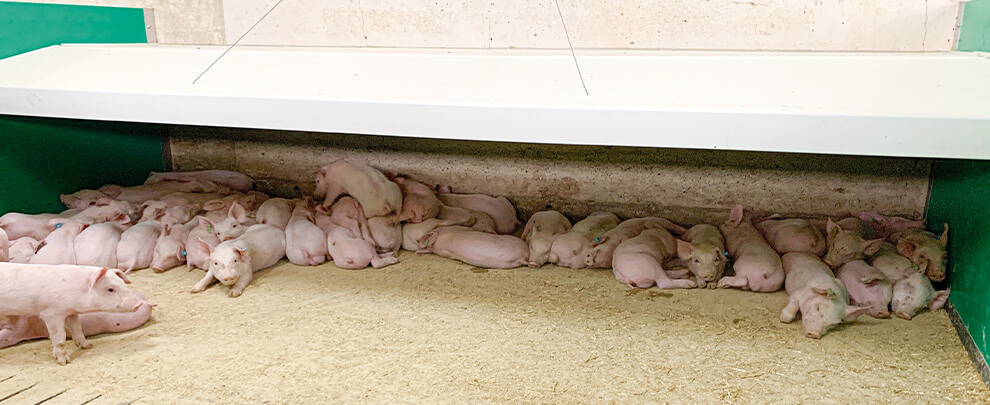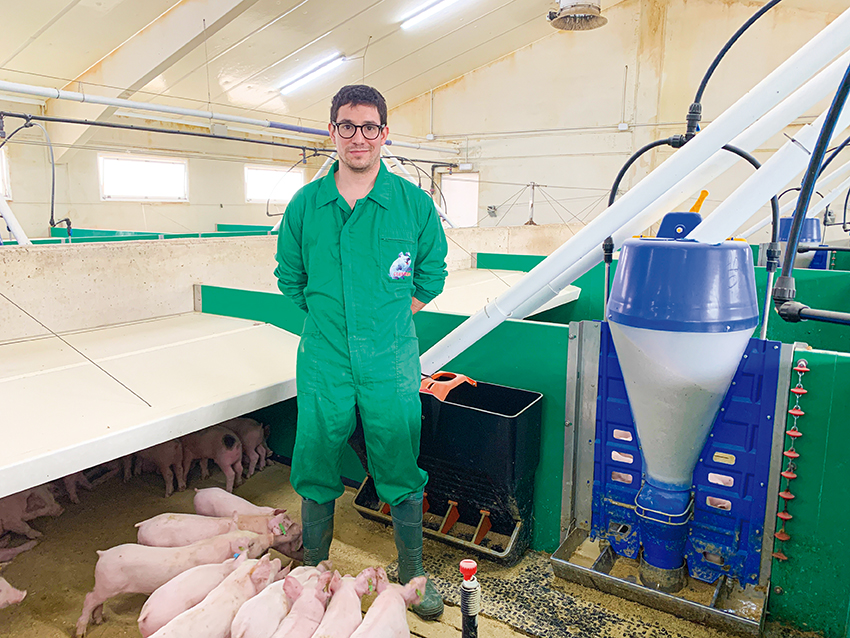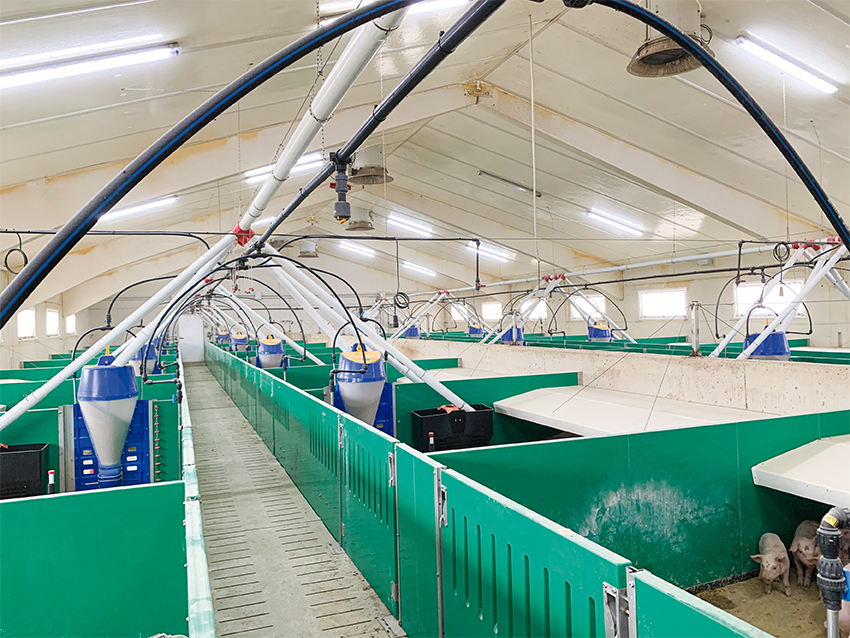Blog
Blog

Discover all the advantages of the Rotecna weaning nest
18th March 2021 - Success stories
Jordi Farrés’ bond with the pork industry begun in his childhood. The son of a rancher, this young vet spent his childhood surrounded by pigs, and that’s when he decided that was where his future was. Farrés currently works as a veterinarian responsible for the transition section of the Aragonese livestock company Cuarte S.L. Under his supervision is the Jalaebro 8 farm, located in the Oscense municipality of Castejón de Monegros. In their quest to achieve maximum well-being and comfort for the animals that stay on this farm, they relied on the installation of Rotecna’s Ni-2 Weaner. As he points out, in recent months, they have already been able to verify the main advantages of this product.

Jordi Farrés in one of the pens with Ni-2 Destete installed. Photo: Rotecna.
What is the origin of the farm?
Jalaebro 8 is an installation by Cuarte S.L., which began construction approximately three years ago and was done to use as a transition that housed piglets from a sows’ farm owned by the same company.
How is it distributed?
The farm has 15,000 transition spots that are distributed in six equal areas. Each of them can accommodate up to 2,500 piglets in transition, with a total of 56 pens per room and between 40 and 45 animals housed in each enclosure. In this way, the piglets are housed on the farm for around six weeks, with a weekly rotation in each of the rooms that make up the facility.
How many people work at the farm?
We have five employees. We have a person in charge, Roque Campoverde, who has a long history and experience with livestock, and three people work with him, helping him in day-to-day work. And finally, I’m the vet.
"Working with two climates in transition offers
advantages that go beyond the well-being of piglets."
You recently installed the Rotecna Ni-2 Weaner. What led you to make this decision?
We were mainly looking for a solution that would improve the piglets’ well-being upon arrival at the farm. To this end, we installed Rotecna’s Ni-2 Weaner because they provide greater comfort for the piglet, generating inside an area, a higher temperature, ideal for their rest.
How do they work with Rotecna’s NI-2s?
We have the nest lowered entirely during the first two weeks of transition. As the days goes by, it gradually rises to reduce the temperature little by little and thus be able to provide greater comfort to the piglet adapting it to its ideal temperature. The Ni-2 Weaner are installed in the same way on all areas, covering almost the entire blind zone used as a bed. As the nest rises, the covered area is reduced compared to the blind spot, and thus the piglet can choose where it feels best to rest.
The Ni-2 Weaner allows working with two climates in transition. What are the advantages of this when it comes to animal health?
Working with two climates in transition offers advantages that go beyond the well-being of piglets. For the piglet, it is ideal because you create a higher temperature area where the animal will stay when it needs it. Besides generating an area with a lower or colder temperature, you make the piglet also defecate and carry out other activities in that area, leaving the rest area cleaner. Another advantage is that energy consumption is significantly reduced, making the farm more sustainable and optimising costs. Regarding animal health, nests allow greater ventilation of the rooms, which provides a better environment.
"The use of nests can help to reduce mortality
rates considerably in the first weeks of life."
Have they managed to reduce death rates?
The use of nests can help to reduce mortality rates considerably in the first weeks of life. The piglet’s arrival at the transition farm is his most critical moment. In this sense, everything that can provide them with greater safety and comfort will help reduce mortality rates and improve production rates.
Do they allow for a good cleaning?
The plastic with which these nests are made is of good quality and easily cleaned. Plastic is a material that is always easier to clean and is therefore much more hygienic.
"Working with nests in transition compensates
for the extra cost of equipping the facility."
Economically, does it compensate for the investment involved in the installation of Rotecna weaning nests?
Yes. Working with nests in transition compensates for the extra cost of equipping the facility. Building the farm is only done once, but the energy expenditure is always there. With nests, the piglet will always have greater thermal comfort. Therefore, the installation of this product has a safe economic return.
As for animal feed, how many feeds do you work with?
In the transitions of Cuarte S.L., we work with five different types of feed. First, we have the lacto-replacement, a milk substitute for piglets with lower weight who need a greater caloric intake. Second, we have the lacto-initiator feed, a moderate protein feed as a flour that helps the piglet heave. Third, we have a pre-starter, C1 and a C2 starter; finally, as the animals gain weight, we give them some of the first feed for fattening.
What other Rotecna products do you have on the farm?
All the plastic products we have are from Rotecna. We have the panels that outline the pens, the TR5 weaning hopper, the Swing R3 hopper and the bowls. Of these, the TR5 stands out for being one of the best hoppers I have worked with in the transition stage. Its regulation is straightforward and allows the feeding of several piglets simultaneously, which is very advantageous.
Regarding the panels, what advantages would you highlight?
Plastic panels greatly facilitate cleaning compared to concrete partitions. Furthermore, the way they are installed, welded instead of screwed on, they have greater resistance and robustness.
In general, what do you value about Rotecna?
Mainly, we value the quality of their products, since we have corroborated their usefulness and good finishes in all the time we have been working with them. Besides, we also value their technical service since they have always offered good support. Finally, I would highlight the research and work behind each of the products.

One of the rooms equipped with Rotecna products. Photo: Rotecna.
In the face of existing health threats, what biosecurity measures do you adopt on the farm?
We have implemented strict biosecurity measures on this farm because we consider this aspect vital in the pig sector’s future. We have a biosecurity fence around the perimeter and a single entrance to the farm with three distinct areas: a dirty area where we leave street footwear; after crossing it, we come to an intermediate zone where we change our clothes and from there we go to the clean area where all the clothes and shoes we wear are unique and exclusive to the farm. On the other hand, to prevent trucks from entering our facilities, they give us the feed from the outside, and we do the entry and exit of animals in the same way, with loading areas that prevent the driver from entering the farm or having close contact with the farmer. Finally, we have a single outlet for possible casualties that we may have on the farm.
At the health level, what are your main concerns?
In the current situation, the disease that all veterinarians working in the pig sector fear the most is African swine fever (ASF). To prevent its entry into our farms, we place a lot of emphasis on biosecurity. On the other hand, we also have other diseases known in the sector, such as PRRS, meningitis, diarrhoea post-weaning, etc. Avoiding their appearance on the farm is possible if we work efficiently and implement adequate biosecurity measures.
What future challenges arise?
We hope to be an industry standard in terms of weaning production for the company and yield healthy piglets that produce quality food and consumer insurance after a fattening phase on other farms.






